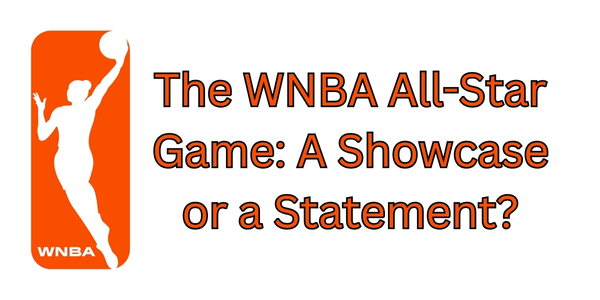The 2025 WNBA All-Star Game in Indianapolis was billed as a celebration of the league’s growth, talent, and future. With rising television ratings, surging attendance figures, and the continued popularity of rookies like Caitlin Clark, this year’s festivities had every reason to be an unequivocal triumph for women’s professional basketball.
But what should have been a night of unity and excitement became mired in off-court controversy, murky narratives, and a protest that risked alienating fans rather than rallying them.
Clark and Reese Deliver on the Court
On the hardwood, the game was everything fans hoped for. Caitlin Clark wowed the crowd with a dazzling display of deep threes, laser-sharp assists, and crowd-pleasing flair. Angel Reese continued her impressive rookie campaign with a dominant presence in the paint. Both players reminded everyone that the future of the WNBA is bright, diverse, and deeply talented.
The on-court product was excellent. It was fun. It was what a showcase should be.
But then came the rest of it.
“Pay Us What You Owe Us” Protest Overshadows Celebration
During the pre-game warmups, every All-Star Game participant from Team Clark and Team Collier wore T-shirts bearing the phrase “Pay us what you owe us.” This protest, organized by the Women’s National Basketball Players Association (WNBPA), was a response to what players called a “wasted opportunity” during initial labor negotiations with the WNBA earlier that week. The shirts were meant to highlight player dissatisfaction with salary structures, revenue sharing, and maternity benefits.
While players have every right to use their platform to raise awareness, the choice to stage this protest during the All-Star Game was unfortunate for several reasons.
The Problems with the Protest
1. Poor Timing and Venue
The All-Star Game is meant to be a moment of celebration—a time to bring in new fans, honor veteran talent, and inspire the next generation. Turning it into a stage for labor protest undercuts that moment. It risks making fans feel like they’re being dragged into a boardroom instead of watching a basketball game.
2. Oversimplification of Complex Issues
Labor negotiations are not simple. Collective bargaining requires nuance, patience, and compromise. The slogan “Pay us what you owe us” may feel empowering to players, but it grossly oversimplifies the issues at hand and can easily alienate people unfamiliar with the details. It presents the league as greedy or oppressive without offering clear solutions or acknowledging the league’s growth trajectory. For example, the WNBA recently reported record viewership numbers and continues to expand national exposure, but is still working toward profitability.
3. Tone and Audience Disconnect
The confrontational tone of the protest likely didn’t resonate with casual fans—many of whom are just now discovering the WNBA through stars like Clark and Reese. This is a critical moment to expand the league’s base, and first impressions matter. If the first thing new viewers see is discontent and protest rather than passion and excellence, they may not stick around.
Commissioner and Union Responses
WNBA Commissioner Cathy Engelbert described the talks as “very constructive dialogue,” while WNBPA president Nneka Ogwumike said the protest was designed to “set the tone” for negotiations moving forward. Players expressed frustration that progress hadn’t come fast enough and indicated that more public pressure may follow if the league doesn’t act.
But this tension between internal labor disputes and external fan engagement is a delicate one. If not managed carefully, it risks undoing the goodwill and enthusiasm that has been slowly building—largely thanks to breakout stars and increased media coverage.
Growing the Game Requires Strategic Messaging
It’s crucial for WNBA players to fight for fair compensation and working conditions. However, the methods and venues they choose to advocate matter. Players are the face of the league, and with that comes the responsibility of bringing fans into the story—not shutting them out with one-dimensional slogans or confrontational messaging.
There is a way to be bold, creative, and effective in advocacy without overshadowing the sport itself. The 2025 All-Star protest may have succeeded in uniting players, but it failed to inspire widespread support or deepen public understanding.
Final Thoughts
The WNBA is on the rise. Its players are more talented, visible, and influential than ever before. But with that influence comes the responsibility to lift the game, not just themselves. True growth—economic, cultural, and athletic—will come not from protest alone, but from a thoughtful combination of performance, passion, and persuasion.
References:
- ESPN: ‘United’ WNBA All-Stars wear ‘Pay Us What You Owe Us’ shirts
- The Guardian: ‘Pay us what you owe us’: WNBA All-Stars make statement with warmup shirts
- CBS Sports: WNBA All-Star Game 2025: Caitlin Clark, other stars wear ‘Pay us what you owe us’ shirts amid CBA negotiations
- Yahoo Sports: Caitlin Clark, WNBA Players Protest Pay With All-Star Pre-Game Outfits
- The Big Lead: WNBA players make strong statement during All-Star Game warm-ups amid CBA drama
- US News: WNBA All-Stars Make Statement With Warmup Shirts Over CBA
